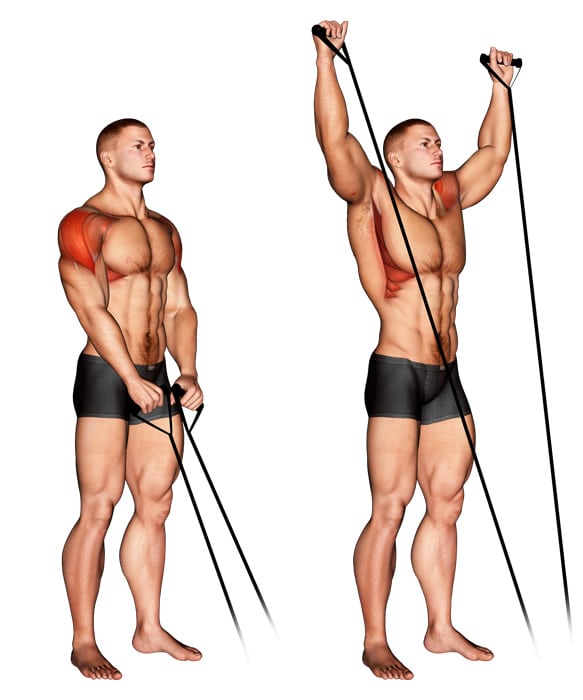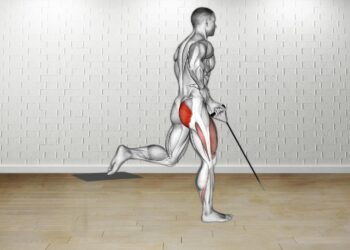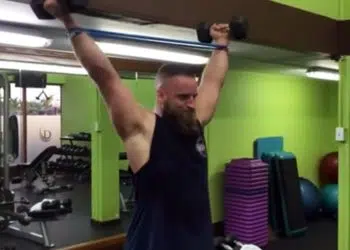The band Y-raise is a precision-based isolation exercise targeting the backside shoulder muscles in addition to the rotator cuff, entire shoulder joint, and two bottom-most heads of trapezius back muscles. Collectively, these muscles engage to either stabilize or create backward and downward motion of the shoulder blades and arms. Moreover, you’ll look better as a result of improved posture, while seeing your lifting numbers improve from a reinforced posterior chain.
In this guide, we’ll explain the advantages of Y raises, the best technique tips, common mistakes, variations, and more.
How To Do The Band Y-Raise
A nice option for all training levels, band Y raise is a convenient technique that you can insert in at any time in your workouts sessions due to its low intensity, low stress nature. To ensure you’ve got the right idea, we included the move in just seven steps, with a brief video instructional for those who prefer to see the technique in motion.
Steps
- Anchor your band to a sturdy object at a height of somewhere between your waist and chin.
- Grab the band with your hands spaced roughly shoulder width and a half distance apart.
- Take a small step back and away from the anchor point to create a little tension in band, while keeping your arms extended forward.
- Retract your shoulders.
- Lift your arms straight up above your head in a Y shape while pulling the band apart, and squeeze the upper back muscles.
- Bring your arms back down to the starting position held straight in front of you.
- Repeat this exercise until you’ve completed the desired number of repetitions.
Tips
- Your starting position will depend on the type of resistance band. If using a looped band, grab it wide from the start. However, if you choose the double sided bands, you can begin the movement with your hands close together, then pull the arms wide apart to complete the Y-raise. Although starting with a wide grip will pre-activate the outer shoulders.
- Use a lying prone position on a bench for more lower trap development.
- Choose a lighter band for Y raises as the movement can be quite challenging. Moreover, going too heavy can stress the lower back.
This Exercise
- Target muscle group: Deltoid posterior
- Type: Hypertrophy and function
- Mechanics: Isolation
- Difficulty: Intermediate
Muscles Worked During Band Y-Raise
A good deal for what it offers in overall muscle stimulation, band Y raises will light up so many muscles in your upper rear torso. Let’s briefly go over their anatomy together so we can understand the importance of these muscle groups.
- Deltoid posterior – Underrated but equally necessary for impressive shoulder development, the rear deltoids stand on their own to give the rear a more three dimensional appearance. Prisoner to its placement and fibers, the posterior delts give us rearward moving ability of the arm. Like when you perform a back row.
- Deltoid Lateral – Wrapped on the side of the shoulder, the lateral or outer delts create the rounded, capped off look from a front or rear view. These fibers lift the arm out to the side.
- Lower trapezius – The lowermost sitting head of the tri-muscle trapezius, middle trap fibers fill space in the upper and middle back, starting broad at the top and narrowing down into a point. Down lowest, the mid traps have to drop the scapula downward.
- Middle trapezius – Like a long pad that supports a barbell during squats, the middle traps sit across the upper back and shoulder area. The unique fiber location pushes the upper muscles back toward the rear like when retracting the shoulder blades.
- Infraspinatus – Like mini wings that connect at both your scapula and upper arm bone, the infraspinatus can’t help but act as a shoulder stabilizer and outward mover of the upper arm.
- Serratus anterior – Not to be mistaken for the obliques, although similar in appearance. Serratus anterior muscles are more horizontal, running from the armpit down, while obliques are angled, lower, and slightly more anterior facing.
- Butt, legs, and core – In the standing variation of band Y raises, you’ll need to activate a level of glute, hamstring, calf, and core power to help keep you stable.
Benefits of Band Y-Raise
A high return, low investment exercise, the band Y raise punches well above its weight class. Let’s talk about what you can expect from this beginner technique.
Level Up Your Fitness: Join our 💪 strong community in Fitness Volt Newsletter. Get daily inspiration, expert-backed workouts, nutrition tips, the latest in strength sports, and the support you need to reach your goals. Subscribe for free!
Superior mid/lower trap and infraspinatus exercise
In a study comparing the effectiveness of various common back exercises, Y raises outperformed the others when it came to lower traps, middle traps, and infraspinatus muscle activation. Y raises are a great exercises to balance out overpowering upper trapezius muscles, and train the unique functions of the prominent muscle groups.
Build unbreakable shoulders
Compared to a face pull, for example, maintaining extended arms is going to have favorable implications on the shoulder. Racking up stability points while strengthening the upper body in a lengthened position, you’ll see better performance in pressing movements that rely on strong scapular and latissimus dorsi muscles.
Less taxing on the body
Band Y-raises are like shifting your training efforts into eco mode. It’s a lower intensity exercise that requires less overall energy compared to movements that must recruit more muscle strength. Therefore, band Y-raises are energy preserving, and hence you can do them before or after a training sessions.
Prehabbing exercise
Y raises are a great prehabbing technique to strengthen and build back up the rear muscles in your upper body following injuries.
Common Mistakes During Band Y-Raise
We recommend avoiding these common training mistakes when perform the band Y-raise.
Training beyond your strength limitations
A heavy lifter may be more inclined to want to use more resistance without ever having done an exercise before. And this can cause joint issues because you’re pushing the shoulder area to do something it hasn’t yet adapted to. Loading too much can also cause you to hyperextend the lower back which we don’t want, especially if you’re using this exercise for pre/rehabbing purposes.
Band Y raises should be performed with light to moderate resistance in a 10+ rep range before considering increasing the load.
Bending your elbows too much
There’s a difference between a Y raise and a face pull. The former is done with mostly straight arms while the latter involves a large degree of elbow flexion. Both have their own benefits, but for the Y raise to be most effective, you want long arms.
Variations and Alternatives of Band Y-Raise
We’re not saying these variations and alternatives are better, although they are a bit different in terms of your body position.
Level Up Your Fitness: Join our 💪 strong community in Fitness Volt Newsletter. Get daily inspiration, expert-backed workouts, nutrition tips, the latest in strength sports, and the support you need to reach your goals. Subscribe for free!
Standing band Y-raise
Don’t have a sturdy object to anchor your band too? Band and feet go together like peanut butter and jelly. They’re made for each other, and you can replicate most movement without needing anchor point.
Steps
- Step down on your band to anchor it against the floor. You can use one or two feet.
- Grab the band in both hands using a neutral or overhand grip.
- Start with your arms down, straight, and held in front of you.
- Raise your arms straight up overhead in a Y shape.
- Lower the band then repeat as many times as needed to complete your first set.
Kneeling band Y-raise
Erasing the legs from a band Y-raise will force you to use everything from the hamstrings and upward including the butt, core, and back muscles. As mentioned in the following video demonstration, this is a nice prehab, rehab, or circuit type movement, beneficial for anyone, and especially athletes. And, if for nothing else, it’s a nice variation for when you need a fresh Y-raise alternative option.
Steps
- Tie your band down low to a steady anchor point.
- Get in a tall kneeling position on a cushion of some type, and dig your toes into the ground behind you.
- Grab the band in both hands with arms extended forward, and pull it apart roughly the width of your hips.
- Now keeping the arms straight, raise the band straight up above your head while pulling it farther apart, then bring the arms back down to the original position.
- Perform the desired number of repetitions.
Band face pull
Similar in terms of pull direction and muscles activated, the face pull starts with your arms stretched forward and ends with the elbows fully bent, and hands close to your ears. This technique may be slightly better at digging deep into the scapular muscle fibers, and squeezing out every ounce of contraction possible.
If the Y-raise doesn’t agree with your shoulders, then the face pull is a great alternative option.
Learn more about face pulls and their benefits here.
Prone lying dumbbell Y-raise
Done while face down on a training bench, a prone lying y-raise allows you to focus just on the movement because your legs and core are more relaxed, not requiring as much total body input as a standing version.
Steps
- Adjust your bench to a roughly 45-degree incline angle. When performing the exercise, your arms should be able to hang down toward the floor for optimal range of motion.
- Lie face down on the bench with your upper chest near the top, legs extended, toes pressed into the floor, and neck and head hanging off the edge.
- Grab your dumbbells in both hands if you haven’t already, and let the arms hang down toward the ground.
- Pull your shoulders back to stabilize the scapula, turn your hands to a neutral grip, then raise your arms up in a “Y” shape.
- Slowly drop the arms back down then do it again!
Cable Y-raise
As good, if not better than a banded Y-raise is a cable Y-raise. Using a system designed for such training variety will offer you more technique options, ease of tracking your progress, and consistent applied forces at every part of the rep ranges. You just need a cable machine though, which is where a band is better if you don’t have access to one. Not much difference here as for the movement execution, although you’ll need to choose the proper weight.
Band pull-aparts
The band pull-apart is an accessory technique for strengthening and reinforcing scapular function. It’ll work all the same muscles as y-raises, although to varying degrees. Still, it doesn’t require any setup, as you’re just using the back and arm muscles to pull your band apart.
Cable shoulder press
Not all shoulder presses have the same stability and joint integrity building advantages as the cable overhead press. You can utilize the design of a cable machine to challenge anti-anterior strength by forcing the shoulders back against the pulley trying to pull you forward.
Lying prone Y-raise
Bearing a striking resemblance to the Superman exercise, you can lie face down on the floor while holding weights in your hands, and lifting the arms as high as you can to work those back muscles.
It’ll look something like this.
FAQ’s
How many sets and reps should I do?
Band Y raises are not a max load movement. Therefore, we recommend choosing lighter to moderate resistance and focusing more on precision and function.
Aim for 2-3 sets of 8-12 reps to build muscle strength, shoulder stability, and joint integrity.
What's the best type of resistance band to use for this exercise?
The type of band you use won’t limit your ability to perform this exercise. You can use the most common, standard resistance bands of high as long as they’re high quality, and the optimal resistance for your strength ability.
We recommend starting with the lightest band possible as Y raises can be quite challenging. You also don’t want to go so heavy that it forces your back into hyperextension.
Are band Y raises safe for everyone?
While band Y raises are a healthy exercise for the shoulders and scapular muscles, we recommend consulting with a medical specialist if currently undergoing a recovery program for the shoulders, upper back, and neck muscles.
What's the difference between Y raises and face pulls?
If you watch a video example for both movements, you’ll immediately realize the major difference between these two powerful, must-have posterior movements.
One uses a Y shaped arm position to strengthen the shoulder joint while the other is more of a power pull. Both have their own incredible benefits, and you should incorporate them both for variety and to build bulletproof delts and scapular muscles.
Wrapping Up
Band Y-raises belong to an underrated category of exercise that need to be utilized now more than ever before. As technology becomes more and more a key part of our daily lives, so too will preserving the health of our postural muscles. It’s not easy to keep a straight spine, and proper head and body alignment when we’re always looking down, and attentive to our devices.
And that’s why we need techniques like Y-raises, face pulls, and band pull-aparts combined with other exercises to help straighten us out, and prevent potentially serious long term structural issues.
Interested in measuring your progress? Check out our strength standards for Face Pull, Shoulder Press, Superman, and more.









